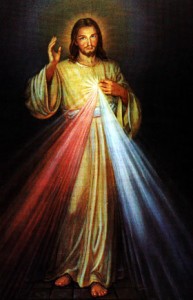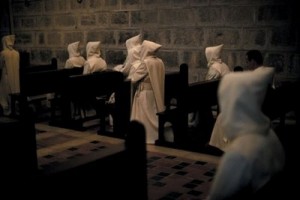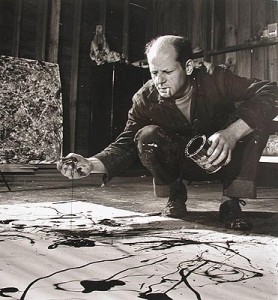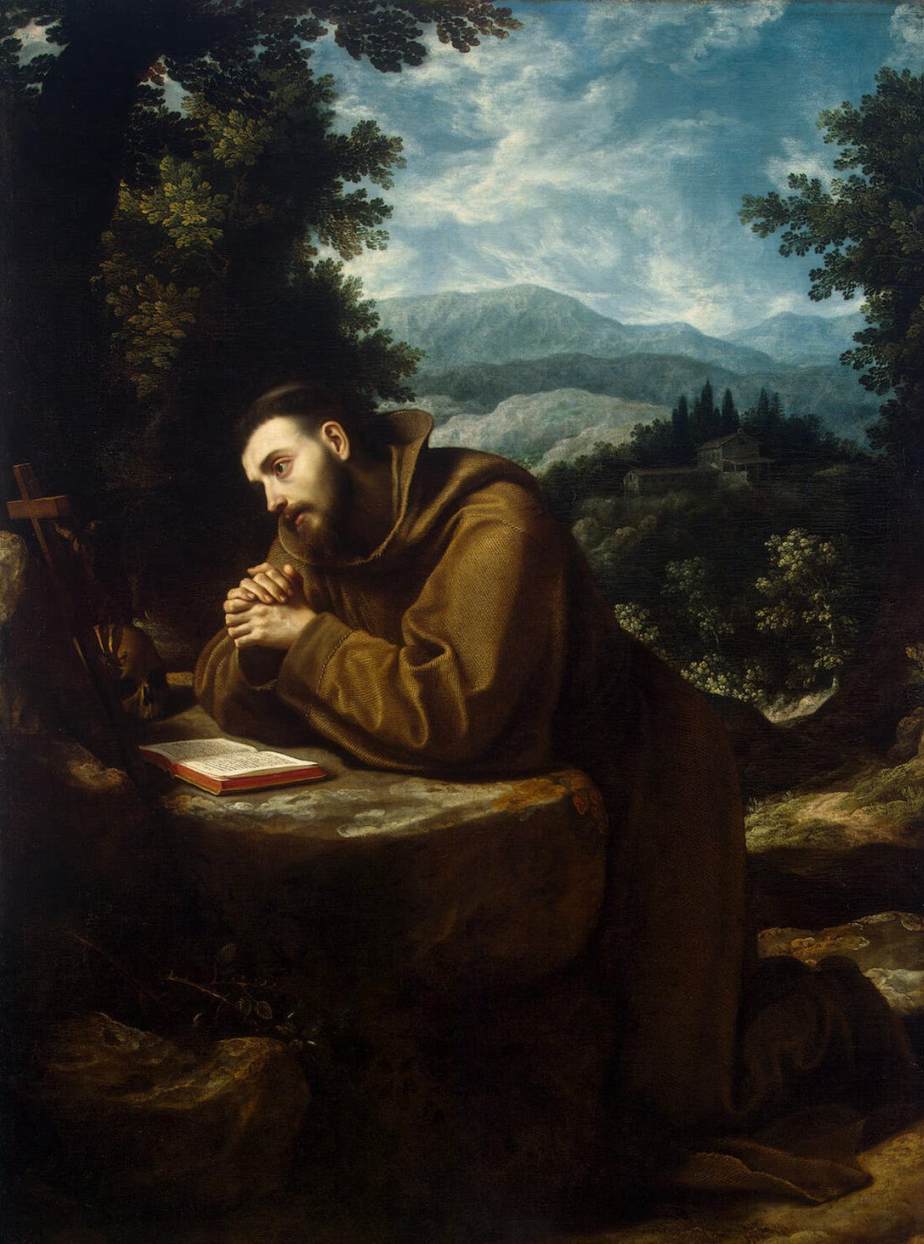It’s the Feast of St. Martha, you know, “the Dragonslayer” today. Yes, you read that right. Father Steve of Word on Fire has a few words about that and they prompted me to dust this off and bring it to the top today. Enjoy!
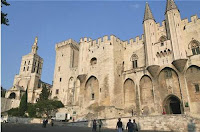
I ate at a McDonald’s in Avignon once. I like to see how Mickey D’s adapts to local tastes abroad. My wife and I also walked around the streets briefly too, before we had to get back on the tour bus that was taking us from Nice to the Burgundy country. See, we rewarded ourselves with a European trip after we graduated from college. It was the Summer of 1993.
It was one of those whirlwind tours. You know the type, right? Eleven countries in 21 days. At the time, I thought we spent way too much time in Rome. It’s amazing I wasn’t arrested there. But that is another story. After Italy, the tour moved on to France. We both loved France ( she still enjoyed Italy, whereas I only approved of Florence). To me, arriving in France was like arriving in Heaven after leaving Hell. I didn’t believe in Purgatory at the time, you see.
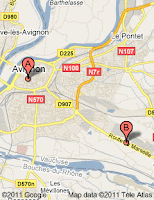 |
| Two McDonalds in Avignon! |
Provence was especially lovely as I recall. And I hope to go back someday, now that I am a Catholic. Why? Because of this little piece of history/ folklore that I stumbled across this morning. I saw on a Christianity timeline that St. Martha, in the year 48-49 AD arrived in Avignon, France. Where I had pommes frites at the Golden Arches? And she brought Lazarus and the gang with her too. Who knew?
I didn’t at the time. So I did a little digging over at Google Books and found about 100 more reasons to head back to Provence. First, I ran across this story in an old magazine named The Century, long since out of print. Why do I want to go back to Provence? Take a look at Exhibit A,
from “The Churches of Provence”, by Mrs. Schuyler Van Rensselaer (November 1894)
“Everything here is on a smaller scale than in Italy — historical facts, as well as those of nature and of art; but thus we are offered a more intimate quality of charm, while we are not saddened by the tragedy of a world-possessing empire gone to wreck.”History meeting legend with a kiss,” we feel ourselves happily enchanted as in a land of pure romance; and the beauty and the gaiety of its living people do but complete the illusion.
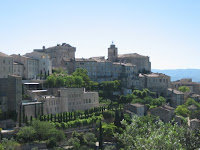 |
| The cities |
“Every foot of this country, every name on its map, is romantically suggestive of Greeks or Romans, Saracens, Visigoths or Franks, Aquitanians or Spaniards, hermits, crusaders, heretics, inquisitors, exiled popes, famous poets, or earliest Christian martyrs. With Petrarch you may go to Avignon and Vaucluse, with Dante to the ancient cemetery called Les Aliscamps in Arles, with Dumas to the islands of the coast, and to Aix with René of Anjou —king, poet, painter, and historian of tournaments. The first monasteries of Gaul were founded upon Provençal islands, and one of them, St. Honorat, long played the prominent civilizing part that was played in Britain by the island of Iona.
“And Christian legend, calling to you at every step, carries you as far back as it could to Palestine itself.
“There is a real town in Provence with the impossibly poetic name of Les Saintes Maries. By the time you reach it on its ultimate point of sea-coast, you should be in the right Provençal mood; and this is the mood of him who saith, “Surely these things are true, else they had not been told.”
 |
| The countryside…Lavender! |
“Just here, we are told, there landed a little company of the friends of Christ, set adrift by their persecutors from the shores of the Holy Land. They were Mary Jacobi, the sister of the Blessed Virgin; Mary Salome, the mother of the apostles James and John; their servant Sarah; Maximin, to whom Christ had restored his sight; Lazarus with his sister Martha; and Mary Magdalene.
“Where and why they had left behind them Mary, the sister of Lazarus and Martha, or whether Provençal belief confounds her with the erring and repentant Mary — this I could not get explained. But I know that Mary Jacobi and Mary Salome remained at their landing-place, for the beautiful name they bequeathed it is a witness. St. Louis caused their bones to be fittingly honored: you may see their tombs today in an ancient church tower, as, in the crypt beneath, the tomb of their servant Sarah; and the medieval pilgrimages still continue, in crowding streams, on an anniversary day in May.
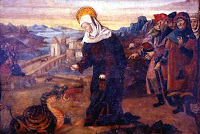 |
| Bad dragon! |
“I likewise know that Martha journeyed to Tarascon, between Avignon and Arles, for there she slew the tarasque, a terrific dragon that was devouring the land: the name of the town is again a proof, and the name of the old church of St. Martha, the effigy of the tarasque, which you may behold, and the festival which year by year is celebrated yet in honor of the prowess of the good housewifely saint. Then at Arles you will learn that Christ himself consecrated for Christian burial the famous pagan Aliscamps (its name is a corruption of Efysii Campi), and at Vienne you will be informed that St. Paul brought thither the first Christian tidings when on his way toward Spain, and will be shown a Roman tomb under which the body of Pontius Pilate was laid.
“And you might just as well have stayed in America as to doubt that such things, told in such ways for nearly two thousand years, must be veritably true.”
****
Dragon slaying? Sign me up! As if that wasn’t enough, her article goes on to describe the church buildings throughout the region with photographs and drawings that magazines of today just don’t take the time to do anymore. I love this story about the early Christians coming to France though and wanted to know more. Here is another taste of Catholic Provence,
from Cathedrals and Cloisters of the South of France by Elise Whitlock Rose (published in 1906)
 “Few of the Cathedral-churches of the Midi are without holy relics, but none is more famous, more revered, and more authentic a place of pilgrimage than the Basilica of Apt. It came about in this way, says local history. When Martha, Lazarus, and the Holy Marys of the Gospels landed in France, they brought with them the venerated body of Saint Anne, the Virgin’s Mother; and Lazarus, being a Bishop, kept the holy relic at his episcopal seat of Marseilles.
“Few of the Cathedral-churches of the Midi are without holy relics, but none is more famous, more revered, and more authentic a place of pilgrimage than the Basilica of Apt. It came about in this way, says local history. When Martha, Lazarus, and the Holy Marys of the Gospels landed in France, they brought with them the venerated body of Saint Anne, the Virgin’s Mother; and Lazarus, being a Bishop, kept the holy relic at his episcopal seat of Marseilles.
“Persecutions arose, and dangers innumerable; and for safety’s sake the Bishop removed Saint Anne’s body to Apt and sealed it secretly in the wall. For centuries, Christians met and prayed in the little church, unconscious of the wonder-working relic hidden so near them; and it was only through a miracle, in Charlemagne’s time and some say in his presence, that the holy body was discovered. This is the history which a sacristan recites to curious pilgrims as he leads them to the sub-crypt…
“To the faithful Catholic, the interest of Sainte-Anne of Apt lies in its wonderful and glorious relics. Here are the bodies of Saint Eleazer and Sainte Delphine his wife, a couple so pious that every morning they dressed a Statue of the Infant Jesus, and every night they undressed it and laid it to rest in a cradle. There is also the rosary of Sainte Delphine whose every bead contained a relic; and before the Revolution there were other treasures innumerable. During many years Apt has been the pilgrim-shrine of the Faithful, and great and small offerings of many centuries have been laid before the miracleworking body of the Virgin’s sainted Mother.”
****
Do you see what I mean? Tidbits like this “Lazarus, being a Bishop…” just give me a thousand more leads to follow up on, and more reasons to go broke heading to Provence. I want to know all about that tradition! As I’ve said before, it will take an eternity of lifetimes to ponder what God has wrought by the Incarnation as well as with the founding of His Church. Unfortunately, it would take a bottomless bank account too. Sigh.
Obviously, Elise’s book is available on the YIMCatholic Bookshelf, though, for unlimited access to all at no charge. I could get lost in this particular book for hours…
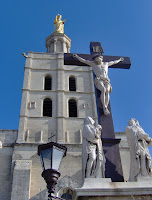 |
Cathédrale de Notre Dame des Doms,
Avignon |







